14 balancing exercises: from sitting to walking
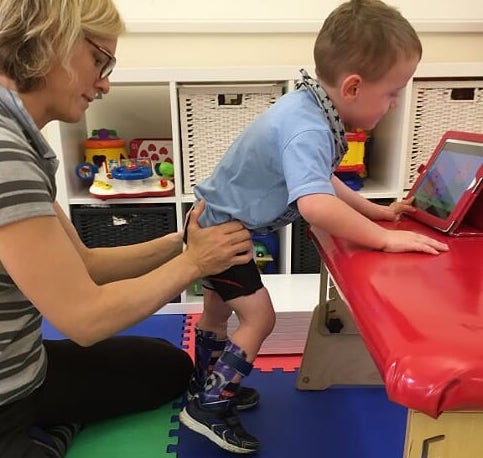

Under One Roof
We need your help with our multi-million-pound campaign, which will secure us a building and fill it with specialist rooms and amazing inclusive sensory and exercise equipment.
Use this sequence to help your child progress coordination and balance in their legs. They may start at the beginning or half way down – wherever they can be successful in their attempts but still be challenged. If your child is not ready to attempt a certain activity, look at those either before or after which may suit them better.
Think about what toy your child can use while they do their activity. Often a watching activity will allow them to balance better (e.g. reading, watching a tablet or TV). Toys that require them to play with their hands will challenge their balance more (posting games, playing musical instruments or playing games on a tablet). Games with many pieces are great for encouraging movement and repetition of the exercise (e.g. throwing a bunch of beanbags or balls, rolling many toy cars, playing shopping with lots of pretend food.)
Before trying these exercises and activities, take a minute to prepare your child. If their legs are tight then stretch the muscles before you try these activities to ensure the most effective movement. To wake up their muscles it can be a good idea to squeeze their legs and feet. You could also use a brush along their skin, or a vibrating massager to give them lots of stimulation. All of these can help to make your child more aware of their legs which can then help them be more accurate and use their legs more effectively.
Make sure your child is successful in their activity as this will motivate them to continue. As you push them to get to the next level, they should be able to manage a few of their attempts to keep motivated – even if they are not successful every time. Moving on to activities before a child is ready may dishearten them and they may well get upset and resist.
Remember to praise the effort made rather than the result achieved, to motivate your child to keep putting in effort and not be put off if they don’t succeed at first.
Sequence of leg balance and coordination
If your child is able to sit still on the floor independently, try sitting them astride your leg, sat astride a roll or on a bench (depending on their size) so their feet are on the floor but their bodies are not resting on anything. Make sure their knees are bent and their feet are flat on the floor.
Once they are able to sit with you just holding at their hips, challenge them to reach out to the side for a toy or reach to the floor and back up. They will need to use their legs to balance themselves and prevent them from falling.
Next, try to raise the bench/ your leg so they have more weight on their legs. Again challenge their balance with reaching games.
Eventually practice this with the bench/ table/ your leg high so that they are just perching on the edge and much of their weight is through their legs but their knees are still a little bent.
You could do this on a small physio ball as well to challenge their balance further, moving the ball side to side to make each leg work hard.
This is a fabulous position to work pelvic stability (as well as core and shoulder stability – see those sections for details)
Start just trying to maintain a hands and knees position. It may be easier to start with your child sitting back on their heels and just balancing through their arms. If they want to shoot forward in this position, keep their bottoms down and hold them at their hips to help them maintain this position.
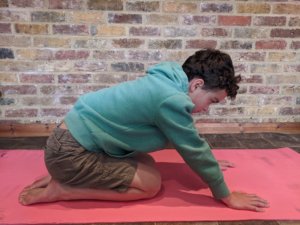
As they get stronger, move their bodies forward bit by bit and see if they can control their hips. If they start to shoot forward again, bring their bottom all the way back to their heels and start again. The aim is to get their shoulders over their hands and their hips are over their knees. While they learn to hold this position, watching activities are the best – watching a tablet, reading a book etc so they don’t have to move their arms.
Once they are able to hold these positions, practice going from sat on heels position up to full hands and knees position and back again with control.
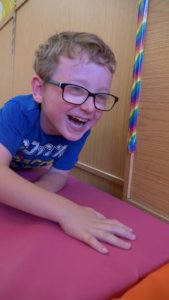 This is a brilliant activity for pelvic and hip stability (as well as shoulder and core stability) and is especially good for those with low tone (floppy muscles) or who are very flexible as it builds stability in the hip and knee joints and can prevent children from building bad habits and hanging on their joints (e.g. locking out their knees in standing) to compensate for their weakness.
This is a brilliant activity for pelvic and hip stability (as well as shoulder and core stability) and is especially good for those with low tone (floppy muscles) or who are very flexible as it builds stability in the hip and knee joints and can prevent children from building bad habits and hanging on their joints (e.g. locking out their knees in standing) to compensate for their weakness.For those with conditions with increased tone in the legs, this position may or may not be helpful so consult your physiotherapist before working on this.
Every time your child moves one leg, the other hip has to stabilise to stop them collapsing. Try to encourage one leg and then the other rather than moving both legs at the same time. Hold onto 1 ankle while they move the other leg forward and then swap ankles.
To challenge the pelvis and hips further, practice crawling over objects or even up some steps. Set up an obstacle course to challenge them further and for lots of fun.
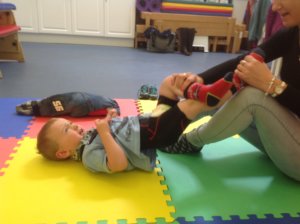 Bridging is good for strengthening their bottom and thighs. Lie your child on their back with their knees bent and feet on the floor. Encourage them to lift their bottom up and down. When they lift it up try to make sure it goes as high as possible – to make a straight line from their thighs to their shoulders.
Bridging is good for strengthening their bottom and thighs. Lie your child on their back with their knees bent and feet on the floor. Encourage them to lift their bottom up and down. When they lift it up try to make sure it goes as high as possible – to make a straight line from their thighs to their shoulders.Once they can lift their bottom high, see if they can hold it for as long as possible. You can try to drive some cars or other toys under their bottom to help encourage them to hold it up.
If their knees come together as they go up, they can hold a ball between their knees while they do this.
Progress to lying your child on their back with their knees bent and feet on the floor or on your lap and encouraging them to lift 1 leg in the air with that knee straight or crossed over the other leg. Now they should lift their bottom, keeping the other leg raised and their hips level, and then go back down again.
As they improve, ask them to try to keep their bottom up for as long as possible with their hips staying level.
Encourage your child to kneel up against furniture – a sofa can be a perfect height for this. Make sure they are in a straight line from their knees up to their shoulders and aren’t bowing forward or sticking their bottoms out. Also be sure that their hips are not swaying side to side. Try correcting your child and then let go so they have to work on their own. Using your hands on them may mean that they lean into your support so try to ease your hands off whenever you can. If they are dropping back down or to the side, use 1 finger to remind them to come back up rather than a full hand.
To begin with the aim is for your child to stay up on their own. Use a book or tablet on the furniture so that, if they drop, they will no longer be able to see it to motivate them to stay up.
Next encourage them to lift a hand to play with a toy so that they are relying less on their arms to balance.
Move onto playing with both hands.
Next, try to keep their chest away from the piece of furniture so that when they play with their hands, they are using even more balance through their hips.
You can now try to encourage them to pick up objects from the floor or even turn to get a toy behind them to challenge them further.
Move their toy further down the sofa or furniture to encourage them to move sideways on their knees.
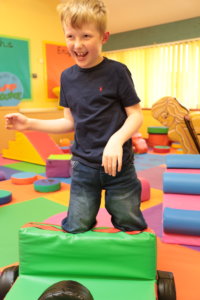
Once they are fully mobile against furniture, try high kneeling without holding on at all. They could even try to walk on their knees in all directions.
Play throw and catch in this position to further challenge their balance.
Set up an obstacle course so they are going over and around obstacles while on their knees.
When your child has mastered high kneeling, help them to bring 1 leg up in front of them so that they have 1 knee on the floor and the other foot out in front (and just to the side) of their bottom knee with both knees at 90 degree angles. Make sure their higher knee isn’t drifting in or outwards. Ask them to correct this or help them and then let go again so they can try to do this themselves.
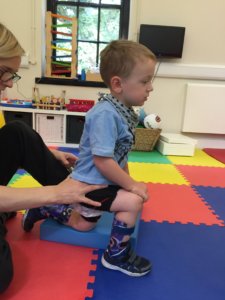
As with kneeling, start by your child holding on to furniture. A bench which fits over their front leg is ideal but they could do this at a table instead.
To begin with you want your child to just stay up there on their own. Use a book or tablet on the furniture so that, if they drop, they will no longer be able to see it to motivate them to stay up.
Next encourage them to lift a hand to play with a toy so that they are relying less on their arms to balance.
Move onto playing with both hands.
Next, try to keep their chest away from the piece of furniture so that when they play with their hands, they are using even more balance through their hips.
You can now try to encourage them to pick up objects from the floor or even turn to get a toy behind them to challenge them further.
If they can manage this, try 1/2 kneeling without holding on to anything. If your child wears splints, it may be easier if their kneeling knee is on a cushion as shown.
Challenge them even further by playing catch in this position. If your child manages this then their hip stability is fantastic!
Practice standing at furniture. Your child should have their legs shoulder width apart and feet facing forwards.
If your child has increased tone in their legs, try standing with their legs a bit wider than hip width apart and with toes facing outwards to help reduce their tone and give them a stretch.
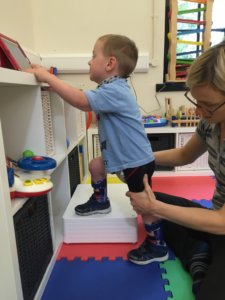
Sit behind your child so you can comfortably hold onto their hips in this position. If possible they should be upright in their body with their bottom tucked in, although this may be something to work towards. If they drop you can guide them into sitting on your lap. If they fall forward on to the furniture, see if they can come up by themselves before helping to re-position them.
If possible, try to release your hold bit by bit on them to see if they can maintain their hip stability and stay upright on their own.
Once your child can stand at furniture – try stepping 1 foot up onto a step to challenge them further. They could step up and down if they feel confident. Make sure the top leg is in front of the floor leg.
Next, ask them to reach to the side and down to pick up objects/ hit a drum/ post an object in a container etc.
This is a fantastic activity to strengthen the muscles on the outside of the leg and also to work whole leg stability and movement.
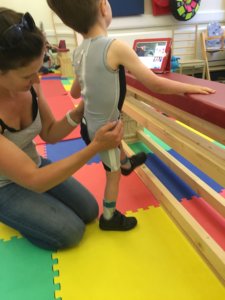
1) Once your child is able to lift their feet to step on a box or re-position their feet while standing at furniture, move their toy out of reach along the piece of furniture to encourage them to walk sideways. You may need to help them move their arms towards the toy. You can then help them by moving their body weight. Their weight should be OFF the side that they want to move.
2) So if they want to go left:
Move their weight over their right foot.
Lift their left hip to encourage them to bring their left foot out to the side.
Move their weight over to their left foot
Encourage them to bring their right foot in to meet the left.
And vice versa for the other side.
3) Once they are cruising happily along furniture, add obstacles in the way – steps to step on, cushions to stand on or toys to step over to challenge them further.
This is a great position to really challenge their balance skills between both legs and should only be attempted once they can stand without you holding on to them at furniture. 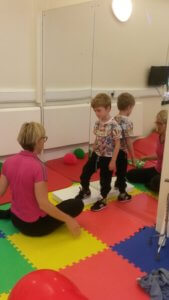
Stand your child with their back to a wall and try and let go (if they are steady enough). Stay close and remind them to straighten their legs if they start to sink. A watching game (TV or reading) is best here as using their hands can put them off balance.
Once they have their balance staying still, help them onto a cushion or wbbble cushion to challenge them further.
Once they manage this on their own, help them to step 1 foot onto a small step/ book and balance like this.
Next try to play a game to occupy their hands – playing on a tablet or target practice with balls and a bucket/ laundry basket.
Finally ask them to walk sideways along the wall to pick up an object and then walk back again to post it. Shopping games or other multi-piece games work well for this.
Start sat behind your child who is in standing with nothing in front of them. Make sure their feet are hip width apart and facing forward. Depending on their personality and understanding you may either want to distract them from what you are doing by letting them watch TV or ask them to concentrate on what you are doing. See what works best.
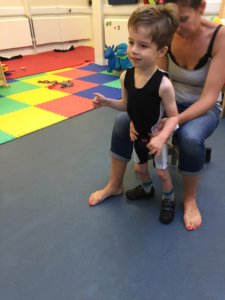
Hold them at their hips. Make your hands lighter and lighter as they start to balance for themselves. Try to let them correct themselves rather than doing it for them – you are there to stop them falling but they need to be able to make small balancing movements within the position.
Slowly move your hands down their leg as they get better at balancing. If at any point they feel stable, take your hands off and let them balance on their own.
If required, keep going down their legs with your hands until you are just supporting them at their feet. This may be particularly useful for your child if they wear splints.
Let go with one of your hands and then swap hands until you can let go with both hands and your child can support themselves.
Go through this sequence slowly – especially if your child is nervous – they should be improving their balance before you move on to the next stage.
Once they can stand with their legs hip width apart and you holding their hips, try very gently to move them side to side over 1 leg and then the other and see how they balance. If you have someone else with you, they could ask your child to reach side to side for objects to help them bring their weight over to each side. If not you can just help them move sideways with your hands on their hips.
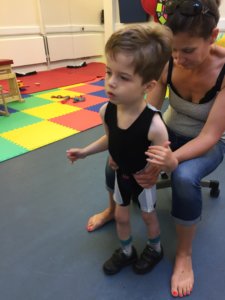
From here, help them into a step standing position – with 1 of their legs forward so they are in a stepping position. Again just hold their hips with their weight evenly distributed between the 2 legs.
If they manage to balance here and you can loosen your hands a bit, try moving them forward over the front foot and back again to their back foot. Again use reaching games to help them move.
Now, for both of the positions above, use the same technique for reducing your support as for standing balance.
Hold them at their hips. Make your hands lighter and lighter as they start to balance for themselves. Try to let them correct themselves rather than doing it for them – you are there to stop them falling but they need to be able to make small movements within the position. Swap which is their front leg throughout the progressions.
Slowly move your hands down their leg as they get better at balancing. If at any point they feel stable, take your hands off and let them balance.
If required, keep going down their legs with your hands until you are just supporting them at their feet. This may be particularly useful for your child if they wear splints.
Let go of one of your hands and then swap hands until you can let go of both hands.
Now try doing the same but with 1 foot on a low step/ hardback book. The foot on the book needs to be in front of the floor foot. This position is very important as it helps to increase the stability in the knee and prevent your child just locking out their joints to stabilise themselves.
Make sure you try a few as they are all slightly different and one may suit your child better. Most have support around your child’s body but may also offer a seat or a saddle to sit on. Your child may be more independent with the saddle but if they are able to manage without, they will get more weight through their legs. Discuss this with your physiotherapist.
Using a Kaye-Walker – If your child has good arm strength and abilities but struggles with core stability, weight bearing on their legs and balance, a Kaye-Walker may enable them to achieve independent walking as they can put much of their weight through their hands.
Forward Walker – If your child has standing balance when at furniture, they may manage to take steps using a forward walker. Here they won’t be able to put their weight through their hands so will take more weight in their legs which will challenge their legs further. This often leads to a better walking pattern but is harder work than the Kaye-Walker. Ask your physiotherapist which is more appropriate for your child.
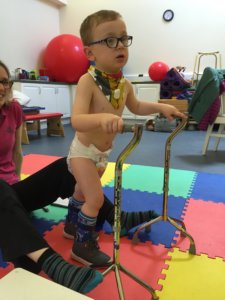
Quad sticks – If your child is managing very well with their forward walker, they may be ready to progress to 2 Quad sticks or Tripod sticks. Make sure that the opposite leg goes forward at the same time as the opposite hand (i.e. right leg with left hand) as this mimics and prepares for walking without a walking aid.
Lastly they may try just 1 stick. If your child has 1 side that is better than the other, the stick should go in the opposite hand and go forward at the same time as the less good leg.
Often, independent standing balance (for a minimum of around 10 seconds) coincides with independent walking.
To lead up to this, practice walking holding your child’s hand or with your child using a walking frame or a stick for balance.
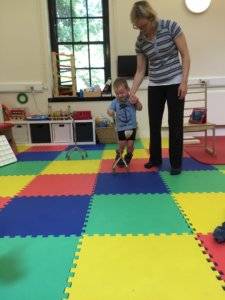
As your child becomes more stable and confident through practice, reduce the support for your child.
If you are walking holding 2 hands, change grip so that you are holding your child but they can’t hold you.
Then move your hands up their arm as they improve until you are able to just hold them at the top of their shoulders.
At this point they should be able to manage a step or 2 on their own and can keep practising until they walk independently.
If your child uses a walker, the progression is to move from a walker to 2 sticks and from 2 sticks to 1 stick until they are ready to just hold your hand and use the progression above.
Trampolining is a fantastic, fully inclusive activity. Your child may well get benefits from having a bit of trampoline fun. Be aware that there are some reasons NOT to use a trampoline – such as if your child has had spinal rodding, There are several other times to be cautious so make sure you check with your physiotherapist before going on the trampoline for the first time with your child.
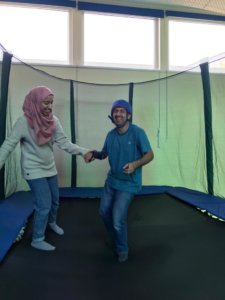
If your child is not mobile on their feet, try them in different positions on the trampoline. For example if your child is able to high kneel on the floor, try them in this position on the trampoline.
If your child can manage hands and knees or half kneel then this can also be tried on the trampoline and, with someone gently bouncing or walking around your child, this is a lovely way to challenge their hip balance (as well as their core and shoulder stability.)
If they are working their standing balance on the ground, try standing holding their hands and just moving the trampoline by shifting your weight to challenge them. This is a fantastic and fun way to challenge their standing balance and will work their muscles very hard.

